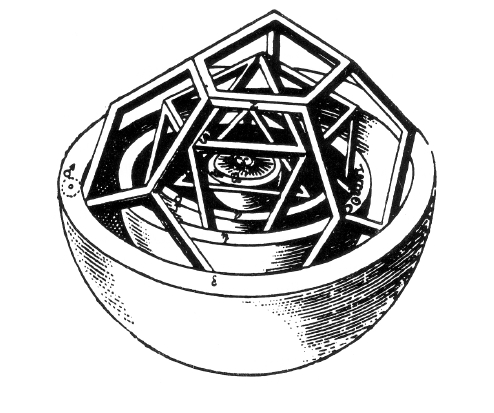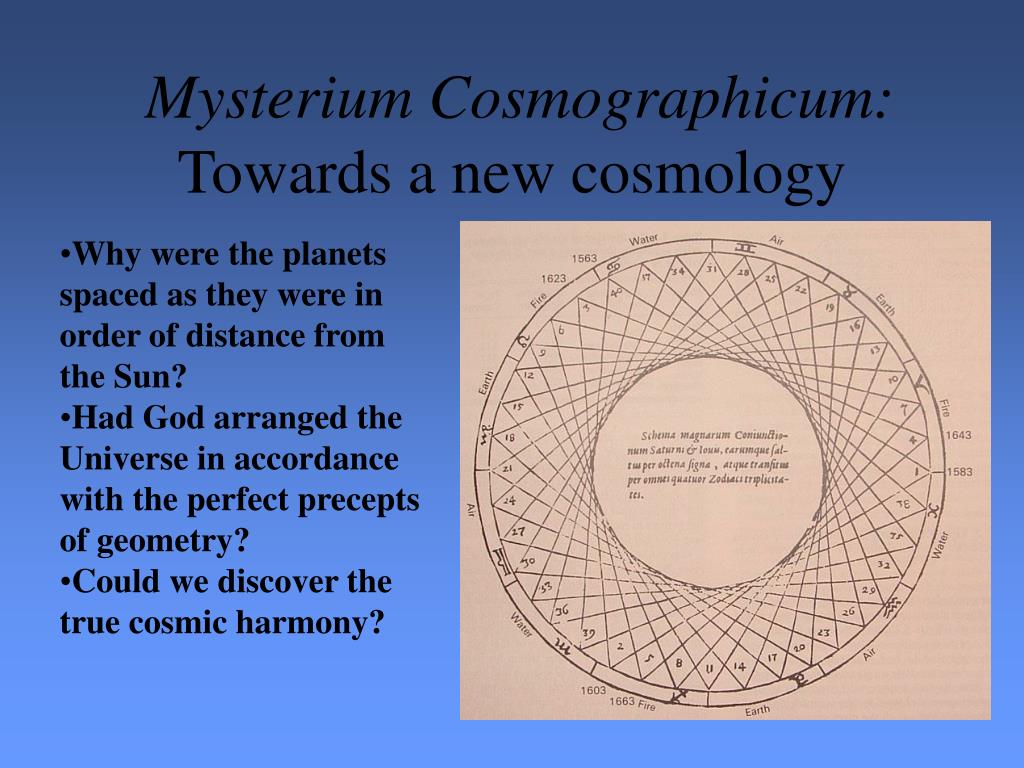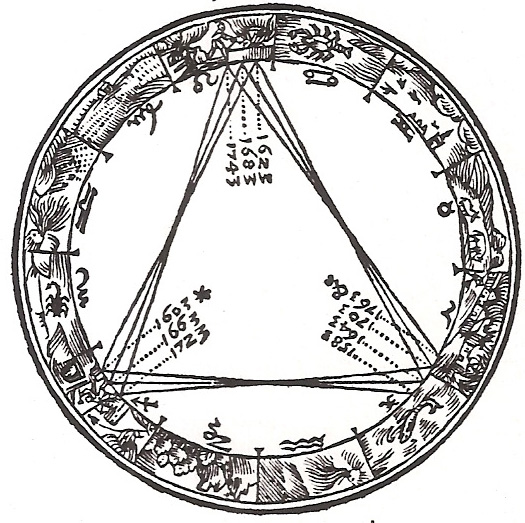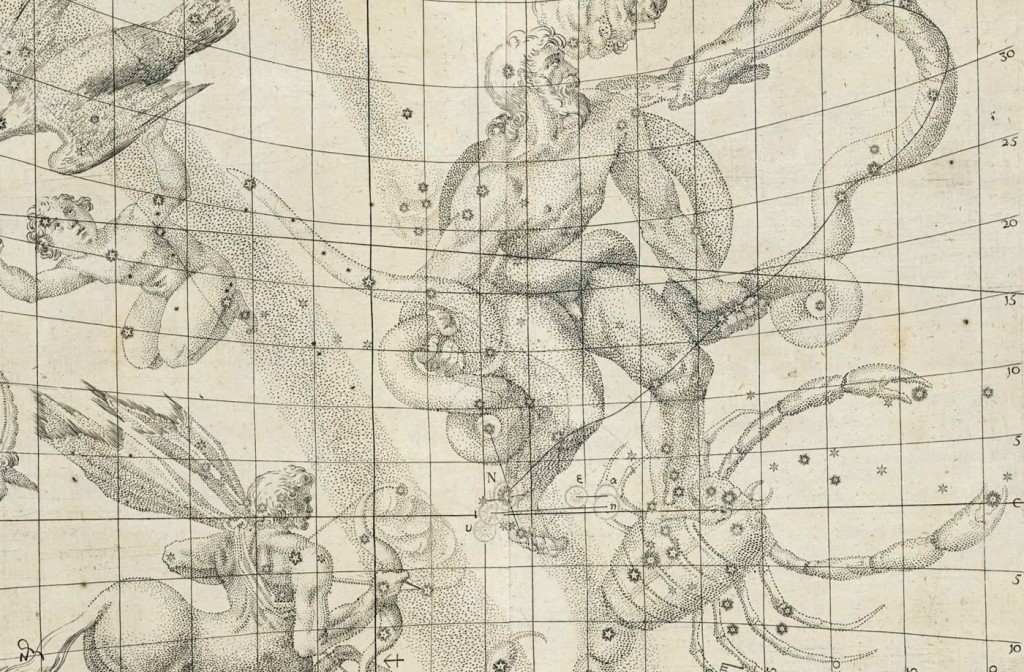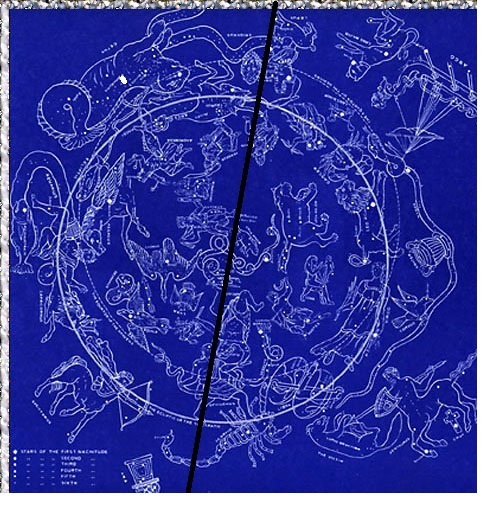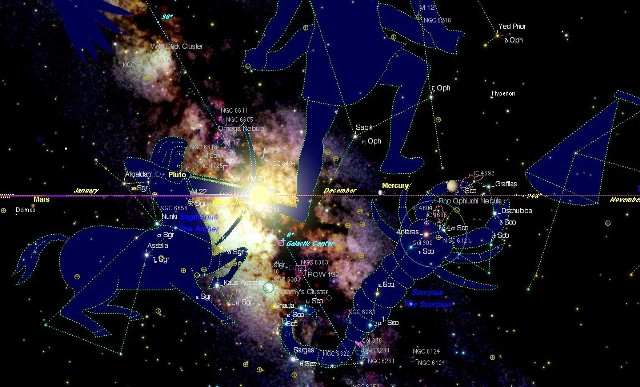
Orion, the Pleaides, the Great Pyramid and Precession. Pt. 2
We concluded Part 1 of this study last month by noting key apex alignments, of the Great Pyramid first with Al Nitak-the [wounded one] and lead star on Orion’s Belt, on Rosh Hashanah of 2017. This was a prophecy of the sacrifice that the “wounded one” endured for all mankind, appearing on the anniversary of Christ’ birth on 9-11-3 BC. Also, the “Scored lines“ in the Great Pyramid’s Descending Passage were aligned to the star Alcyone of the Pleiades-the foundation star, as a 2nd apex alignment of the Great Pyramid, providing a stellar link between Al Nitak and the central star of the Pleiades–Alcyone. There is also a 3rd type of Pyramid alignment on Al Nitak, that we highlight below in Figure 6, from the King’s Chamber star shaft. In this study, we focus on the Biblical Astronomy of the Great Pyramid, Al Nitak on Orion’s Belt, and the Pleiades star cluster.
Job 38:31-32 Can You bind the cluster of the Pleiades, or loose Orion’s Belt? Can you bring out the signs of the Zodiac [mazzoroth] in their season, or guide Aldebaran and its satellite stars? Did you proclaim the rules that govern the heavens, or determine the laws of Nature on the Earth? [REV]
To get the full picture of how the Belt Stars of Orion impact the narrative of this study we should notice their biblical usage. Job 38 is the first of two obvious references to Orion in Job, that we will consider. Job 38:31, specifically refers to Orion’s Belt above, signifying the three stars as a unit in this verse. Since God’s Word refers to these three stars as a unit, and they are a celestial reflection of the three Pyramids of the Giza Plateau, then perhaps we should treat these three Pyramids as a unit also. This is key as we consider a master-plan for the structures of the Giza Plateau, but also good advice considering the rhetorical questions of these verses, since it was the Creator Who “Bound the cluster of the Pleiades, and the belt of Orion.” The implication here is that any attempts by man to counteract the actions of the Almighty in binding the cluster of the Pleiades or loosing Orion’s Belt, would be to man’s own detriment, since men did not “proclaim the rules that govern the heavens, or determine the laws of Nature on the Earth! It also implies the roots of a master-plan both with the celestial and terrestrial versions of this image. This point of the Creator’s emphasis of genesis, that He Made everything from nothing, is brought home in the opening words of the following scriptural references mentioning Orion and the Pleiades together. It also points out the folly of those who emphasize their idol astrological cults, as opposed to the Scriptural approaches of Biblical Astronomy.
Figure 1. The correlation of the 3 Orion’s Belt stars with the 3 Pyramid’s of the Giza Plateau. 1
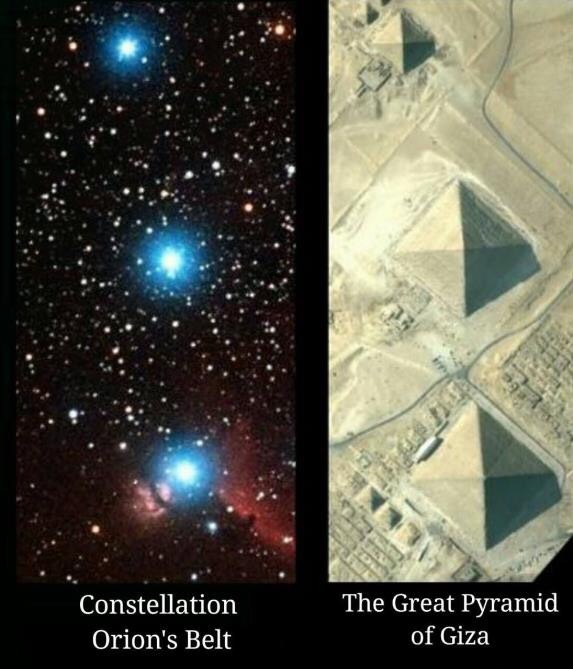
These are key references in the types or categories of biblical “Orion references” that we can identify. A second aspect of Orion reference is the appearance of the Pleiades star cluster in each of the 3 verses with Orion; [Job 9:9, 38:31, Amos 5:8]. The link between the 3 stars of Orion’s belt and the three Pyramid’s at Giza is established by the King’s Chamber star shaft alignment of the Great Pyramid, with the star-Al Nitak, the “buckle“ or 1st star of Orion’s Belt, referencing again Christ’s Sacrifice as the “wounded one” on the cross.
The idea that the three stars of Orion’s Belt are a celestial reflection of the 3 Pyramid’s of Giza, is also key since
it is not by chance that Orion’s belt is situated on the celestial equator-directly reflecting the Giza Plateau in the Earth’s equatorial belt zone, where these 3 Pyramid’s were founded. This is in fact, a central aspect of the “Orion Correlation Theory,” with celestial and terrestrial “belts” reflecting each other. But much more, it suggests an aspect of the Creator’s master-plan, based on the Great Pyramid’s support of Scripture including both Orion and the Pleiades together in these Bible references. Could this be directing our attention to the passages and star shafts of the Great Pyramid, and their interrelated alignments? In this light, we should recall the previous relation pointed out, linking the Descending Passage alignment on the Pole Star (Alpha Draconis), with the “Scored Lines,” in Fig.2- showing their alignment on the Pleiades above the Pyramid’s apex at Alcyone, as another way of illustrating the transitory demise of the fallen Morning Star, giving way to the new Ascendant Morning Star-and capstone Jesus Christ.
Figure 2. The Great Pyramid’s apex alignment with the star Alcyone of the Pleiades star cluster. 2

Within the Descending passage of the Great Pyramid this set of ‘scored lines’ in the wall, point to the star Alcyone, of the Pleiades seen in Figure 2. The Descending Passage was aligned to the north pole, during the pyramid’s construction age, but the alignment of the scored lines with the star Alcyone occurred only on two specific dates: 2123 BC and 3440 BC. Close to the later date, Piazzi Smyth calculated that Thuban was 3 degrees 43 m. from the pole at a lower culmination in 2170 BC, indicating the fallen nature of the 1st Morning Star when Thuban was on the meridian below the pole, as the Pleiades were on the meridian above the pole at the autumnal equinox, above the Great Pyramid’s apex. 3
Another scripture in Job where Orion and the Pleiades are mentioned together is in Job 9. This depicts yet another north polar Decan that “bears” a deeper look. In Job 9:9 it seems the “Bear” was added to the guest list of this celestial party as seen below. In Ursa Major below, the handle of the Big Dipper asterism is formed by the stars of the bear’s tail, as the dipper is part of the bear’s thigh, which is how it was pictured in ancient Egypt’s Dendera Zodiac, before 3000 BC.
Job 9:9 He made the Bear, Orion, and the Pleiades, And the chambers of the south;
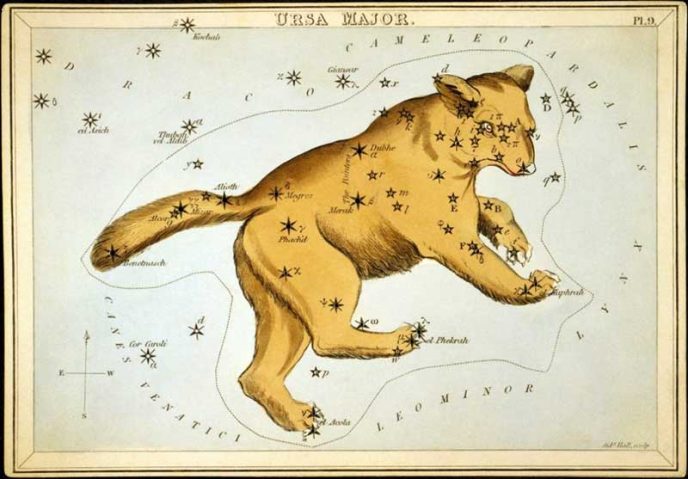
Ursa Major seen above, called the Great Bear is the largest constellation in the northern hemisphere. The Latin name means greater she-bear. Ursa Major is the larger bear in contrast with nearby Ursa Minor, also called the lesser bear. Ursa Major is one of the original 48 constellations listed by Ptolemy in the noted 2nd century BC, work known as the Almagest, containing the asterism known as the Big Dipper. This asterism has two bright stars Dubhe and Merak, that have been used as a navigational pointer. These two stars Dubhe and Merak, point out the current north pole star, Polaris, as seen in the graphic below. The brightest star Dubhe means a herd or flock of animals. The Hebrew word linked to the star name “Dubhe,” is Dohver– meaning a fold. A related Hebrew word– Dohveh means rest or security, giving us what Bullinger calls the security or resting place for the greater and lesser sheepfolds of the Saints, the redeemed of the Jews and Gentiles. 4
Figure. 3 Polaris is the northern Pole star located in the decan of Ursa Minor. 5

The line formed by the two stars Dubhe and Merak points directly to Polaris, the northern pole Star of the lesser fold in Usra Minor, located between the feet of Cepheus the Crowned King at the North Pole. This embodies Jesus Christ ascended, and seated in the heavenlies at God’s right hand, ruling over the entire panoply of stars centered on the Pole, while guarding the 7 stars of his Churches. The star Polaris -the current northern pole star, that inherited its position via the precession of the poles, from Thuban, or Alpha Draco-the archaic pole, that the Descending Passage was aligned on during the construction of the Great Pyramid, is seen in Fig. 4 below.
Figure 4. The Great Pyramid’s Descending Passage aligned on Alpha Draconis [Thuban] the ancient Pole star. 6
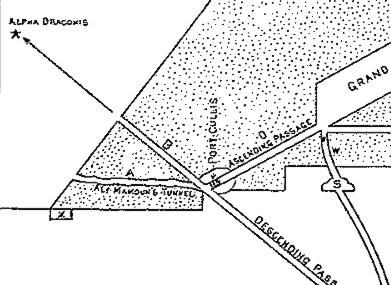
As we have seen, the Scriptures record Lucifer’s failed coup’ against the Almighty, and his resulting ejection from Heaven to Earth, with a third of the Angels, [Rev. 12:7-13]. The ancients believed that mankind’s spiritual enemy, symbolized by the Serpent-tempter in the Garden of Eden, [Gen. 3:1ff] or the astronomical dragon constellations, had caused humanity to sin, destroying the idyllic age, in Earth’s Original Paradise. As seen above in Figure 4, the former pole star Thuban of Draco, was aligned down the Pyramid’s Descending Passage in 2144 BC, into the “Bottomless Pit” below the base of the Pyramid. This tells a narrative in the megaliths of the Great Pyramid, with the Dragon Decan, shining over the Descending Passage, not only of the serpent’s former position as lead Arch-Angel in the 1st Heavens and Earth, but also his desire to take as much of humanity down in destruction with him, just as he did with his third of the heavenly angels.
In contrast, the “Scored Lines” of the Descending Passage were aligned on the Pleiades 7-star cluster, that embody the sweet influences of God’s Blessings on His people. The Pleiades cluster is found on the back of the Great charging Bull– Taurus– who depicts the swiftly returning Lord. The cluster of 7 churches are under the watchful eye of the Lord, as seen in the eye star of the Bull-named Aldebaran, the Head or mighty Captain. This gives us a hint of part of the mystery of the seven stars [I Thess. 4:13-17], because when the Lord returns first, he will raise those saints asleep in Jesus, as God brings them with the Lord, [v.14, 17]. They will be immediately followed by the remaining Saints who are alive at his return. This remains a mystery since only the Heavenly Father knows when this long-awaited gathering will occur. Thus in the oldest book in the Biblical canon- the book of Job, we find the Pleiades and Orion mentioned together, foreshadowing the union of the returning Christ, in the Charging Bull-Taurus coming for the redeemed in his 7 churches.
Orion is thus a symbol of the perfect Man and hero, embodied in Christ represented in Joshua the Hebrew warrior. The name “Joshua,” in Hebrew is the equivalent of “Jesus,” showing an aspect of the dual symbolism of Orion as both the fallen and risen Morning Star. We find in this Biblical reference to Orion, the 2nd of three in Job [9:9, 38:31] also [Amos 5:8], evidence showing Orion’s initial prominence as the figurative light of heaven. If Orion’s belt-line to Sirius (the Dog-star) is realized, then we find the stars of Orion’s belt symbolizing Lucifer’s choral units of angels under his domain, girt about his loins; [Ezek. 28:12-19] This description of Orion’s Belt figuratively resembles the portrait of the king’s glory found in Ezek. 1:25-28, over the heads of the Cherubim.
Ezek. 1:25-28.
25 And there was a voice from the firmament that was over their heads, when they stood, and had let down their wings. 26 And above the firmament that was over their heads was the likeness of a throne, as the appearance of a sapphire stone: and upon the likeness of the throne was the likeness as the appearance of a man above upon it. 27 And I saw as the colour of amber, as the appearance of fire round about within it, from the appearance of his loins even upward, and from the appearance of his loins even downward, I saw as it were the appearance of fire, and it had brightness round about. 28 As the appearance of the bow that is in the cloud in the day of rain, so was the appearance of the brightness round-about. This was the appearance of the likeness of the glory of the Lord. And when I saw it, I fell upon my face, and I heard a voice of one that spake.
The Great Orion Nebula. 7
To the naked eye, the Orion Nebula appears as a blurred central star in Orion’s Sword, south of Orion’s Belt.
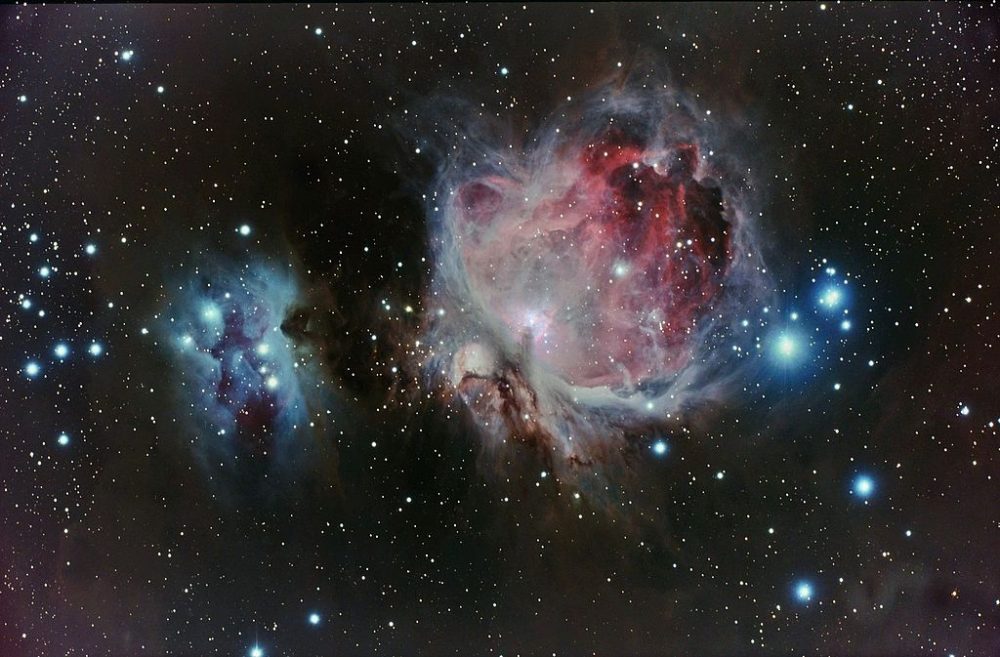
This appearance of fiery glory, of the enthroned man in Heaven, above and below his loins is a manifestation of light, since v. 28 describes it as a rainbow or light spectrum. This resembles the midsection of Orion, closer than any other celestial image that comes to mind, as the name Orion means ‘light of heaven.’ This description also fits the scene mentioned in Rev. 4, of the throne-room, after the resurrections. From v. 27 above ‘from the appearance of his loins even downward, I saw as it were the appearance of fire, and it had brightness round about. As we view this sector below Orion’s Belt, a most prominent area of the sky centers on The Great Orion Nebula; M42 in Orion’s Sword. As Rev. 1:16 reminds us; he that had in his right hand seven stars, and out of his mouth went a sharp two-edged sword, and his countenance was as the sun shining in its strength. [Rev. 19:15, 21] This tells of the Lord’s destruction of the serpent enemy by the sword of the spirit which is the Word of God.
The Sword of Orion below his belt stars is identified with the Messier Object M42.

Lucifer as the angel of light in his first estate, had dominion over the angels in the dawn of time. Once Lucifer fell, his role as the “light of heaven” was stripped from him and set aside, to be transferred and superseded in the rising daystar, who washed out the brilliance of the fallen Morning star with his own Sunrise, symbolized in the Heliacal Rising of Sirius. We are reminded of this imagery, again in Job 38:12-13 [Revised English Bible] as the ancient Egyptians recorded in their daily observations of the skies, when the brilliant light of dawn ‘shakes the Dog-star from the Sky,‘ and in v. 15 ‘when the light of the Dog-star is dimmed, and the stars of the Navigator’s line go out one by one.’ This sky depiction of the fall of the first Morning Star, while dimming and extinguishing his light, drowned out in the Sonrise of the ages, shows the astronomical reality of the truth of Christ’s preeminent light in Scripture, and in the heavens.

The center of these seven stars of the Pleiades, was Alcyone which was the target of the “Scored Lines,” showing the escape from the destruction of the Descending Passage, aligned through the Pyramid’s apex, in Fig. 2. This alignment of the Scored Lines was defined by actual observations at midnight of two consecutive Autumn Equinoxes, in 2145 BC, and on Sept. 22, 2144 B.C., when this conjunction took place. This allows us to see how the Great Pyramid encompasses the juxtaposition of Good and Evil, in the path down the Descending Passage into the pit, set against the apex aligning of the seven stars of the 7 churches, [Rev. 1:16-20], held in the hand of the Lord. Just as the Ascending Passage leads away from the downward spiral of the Descending Passage, so we are afforded an escape from a bleak demise in the pit. Here we find this message of Hope in the Pyramid’s passages, in agreement with the truth of Scripture, for all mankind in Christ our Savior, as a witness to the world in its last remaining architectural wonder. The last and only Hope for mankind thus resides exclusively in Jesus Christ, (Isaiah 14: 12-15, 19: 19-20) as he represents the Alpha/Omega singularly embodied in the Lord, as mankind’s Hope of salvation.
Can you bind the SWEET INFLUENCES of Pleiades? (Job 38:31) Make no mistake, no part of the mystery was ever revealed in the Celestial Gospel, prior to these truths being revealed in the Church Epistles of the New Testament by the Apostle Paul. However, once the scriptural truths were revealed, it became possible with spiritual hindsight to see glimpses of these truths from a New Testament perspective. Peter speaks of this in [1 Pet. 1:8-13] where the faithful persist to see the end of their journey- the completion of their redemption and the salvation of our souls. Which Salvation the prophets inquired and searched diligently, but they could find no evidence of the graceful gap of time called the age of grace between the sufferings of Christ and the glory that should follow…which the angels desire to look into.
Figure 5. Orion’s belt alignment on the Pleiades above Taurus vs. Sirius below in Canis Major. 8
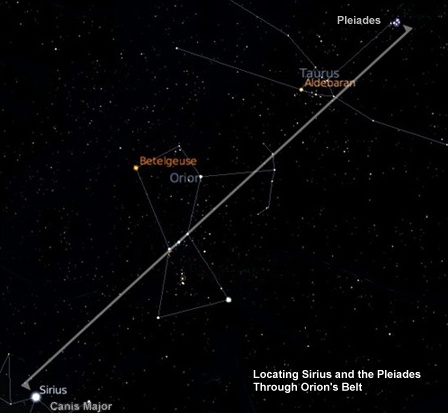
This mystery of the seven stars can also refer to the Angel’s first estate prior to their revolt, when Lucifer as the Bright and Morning Star, led the angels as Morning stars and sons of God, in their collective shouts of joy, praising the Almighty, [Job 38:7, Isa. 14:12-20, Ezek. 28:12-19]. But once iniquity was found in Lucifer, he was cast out of heaven, taking 1/3 of the angels down with him; [Rev. 12:7-9]. This graphic in Fig. 5 reveals an alignment between Orion’s Belt and the 7 stars of the Pleiades, providing a unique perspective of a third Biblical mention of these asterisms in unison.
Amos 5:8 He made the Pleiades and Orion; He turns the shadow of death into morning And makes the day dark as night; He calls for the waters of the sea and pours them out on the face of the earth; The Lord is His name.
The fall of Lucifer transformed him into the angel that casts the shadow of death in the precession of the pole stars from Thuban of Draco, to Polaris or Al Rucabba, of Ursa Minor. And as we just witnessed above in the Revised English Bible version of Job 38:12-15, the light of the Fallen Morning Star was extinguished in the brilliant dawn of the Ascendant Morning Star Jesus Christ, who embodies the turning of the shadow of death into morning, as told by Amos.
“Seek Him that made the seven stars and Orion, and turned the shadow of death into the morning, and made the day dark with night: that called for the waters of the sea, and poured them out upon the face of the earth: The Lord is his name …” [Amos 5:8] KJV
In the ancient Chinese Lunar Zodiac under Emporer Yao, the Pleiades star cluster was among the earliest of Lunar houses on record, dating to 2357 BC, when the central star Alcyone of the Pleiades was near the vernal equinox. 9 Throughout ancient Astronomy, and in the cosmology of ancient Egypt, one of the four-corners or pillars of heaven has always been the vernal equinox. This prominent recognition of the vernal equinox in ancient Astronomy is a major indicator of the consensus of the recognition of the precession of the equinoxes in early antiquity. This key linkage in ancient Egypt, between Orion’s 3 belt-stars and Sirius, not only ties the Sothic Calendar to the vernal point as a precessional marker, but also the lunar zodiac and the sidereal year, as seen in with the ancient Chinese astronomers also. Biblically, the 7 stars of this famed cluster; [Job 9:9, 38:31] are referred to collectively as a “heap or accumulation, and the congregation of the judge or ruler,” the ascendant Morning Star Jesus Christ, said also to be referenced in Rev. 1 as a “mystery.”
Rev. 1:20
20 The mystery of the seven stars which thou sawest in my right hand, and the seven golden candlesticks. The seven stars are the angels of the seven churches: and the seven candlesticks which thou sawest are the seven churches.
Here we find the unity of the angelic realms with the 7 churches of Christ’s spiritual body, in the one accord of harmony in Christ’s return.
We see hints of this imagery embodied in the Pleiades also in Milton’s description of Creation at the dawn of the world, in Paradise Lost; where he says of the Sun, the Dawn and the Pleiades before him danc’d, shedding sweet influence. 10
There is also a fable linked to one of these seven stars, that was lost in infamy. The Poet Aratos wrote;
As seven their fame is on the tongues of men, though six alone are beaming on the eye… 11
Pleiades Star Map

This fable can be traced historically, to the disappearance of the 7th Pleiad star in the time of the Trojan War [1194-1184 BC], where according to Rolleston, “the star shot like a comet towards the North pole,” leaving only six main Pleiad stars. One of these was named “Maia” in Greek, tracing to the Chinese “Mao,” preserving the ancient Chinese historical roots of this Pleiad, in their Lunar Zodiac of the 23rd Century BC. 12 This reveals the historical influence of the Lunar Mansions, and their role in understanding luni-solar cycles with star cycles and the sidereal year. A “sidereal year” is the period of the Sun’s transit over the Meridian of the same fixed star on the ecliptic, consisting of 365.256 days. The Dogon of West Sudan, and the ancient Egyptians, made use of the Sothic Calendar based on the Dog-Star Sirius of Canis Major, the brightest star in the heavens, as the basis of their star religions. As the Creator timed the stars and planets into orbit, He set the sacred 50-year Hebrew Jubilee period, first seen in astronomical history in the path of the star Sirius “B,” and its 50-year orbit around Sirius “A.” We have shown evidence that Bible Patriarchs, like Noah also recognized the Sirius cycle, which is covered in our website study on Noah’s Calendar. The Sumerians and Babylonians also shared the use of sidereal calendars based on Sirius’ binary system, with the Babylonian goddess Ishtar, as a mainstay in their idol pantheons, applying a symbolic link to the Morning Star in both Venus and Sirius, the Dog-star. Ancient Egypt however, had the strongest ties to Sirius, as they called it the Nile Star, since its annual rising would coincide with the Nile floods, upon which their agriculture depended. The star Sirius was notable in Great Pyramid astronomy, whose Southern Star shaft of the Queen’s Chamber, was aligned on Sirius-seen below, in Fig. 6.
Figure 6. The Star Shaft alignments of the Great Pyramid.

Just above the Queen’s Chamber is the southern star shaft of the King’s Chamber, aligned on the lead star of Orion’s belt–Al Nitak, the wounded one. This also depicts an astronomical relation between Orion’s Belt and the star Sirius, found in Figure 5 above, as the three Orion Belt Stars point towards Sirius the dog-Star. What follows is an important part of our thesis that establishes Sirius’ dual symbolism, linked with the Morning Star. A well-established standard of astronomical navigation is finding the rising point of Sirius once Orion has risen at least 20 degrees, by extending the so-called Navigator’s Line [Fig. 5] of the 3 stars of Orion’s Belt to the horizon.
The Dogon celestial mythology says that the cycle of Sirius “B,” a White Dwarf companion star in joint orbit with Sirius “A“, is a 50-year cycle, a fact verified by modern astronomers. Thus, it is instructive to see how half the fifty-year cycle of Sirius “B“ exhibits the luni-solar kinship inherent in the 50-year cycle of Hebrew Jubilees, according to the golden section, or phi ratio. This is central to the celestial coordination of the luni-solar cycle, along with the Sirius star cycle as the three major calendars referred to in Gen. 1:14-16. Since the Sirius year, or Sothic Calendar as the Greeks called it, requires highly advanced knowledge of the heavens, capable of selecting the lone star in the sky that dictates a year–365¼ days long, we find more support for these advanced astronomical practices centuries prior to Abraham.
The Stars of the “Navigator’s Line” in Orion’s Belt and sword with Sirius to the left.
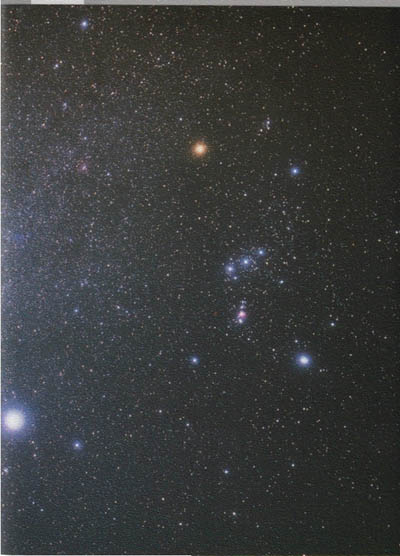
“Stars of the Navigator’s Line go out one by one“- These stars of the Navigator’s line-the three belt stars of Orion, that “go out, or are extinguished, one by one” as the sunrise of dawn washes out their nocturnal brilliance. This imagery fits a symbolic portrait of 1/3 of the stars of the heavenly host, under Lucifer’s domain, taken down with him when he fell from grace, resulting from his mutiny in the First Heavens and Earth. Their light was snuffed out due to their revolt as they were broken in the light of the rising daystar, the ascendant Jesus Christ. When we read this rendering of Job 38, in light of the Heliacal Rising of Sirius, the truth of this text lying hidden here for millennia finally comes to the surface. This is most fitting since Job and Genesis, are the only books addressed to the Age of Biblical Patriarchs, whose gospel was the stars! This also shows the high degree of sophistication in the Astronomy of the Biblical Patriarchs at a very early time in the antediluvian age. This is a witness to the ancient knowledge of the Sothic cycle in Job, based on the cycles of the dog-star Sirius, related to Orion’s belt, illustrating how the Patriarch Job provided a transition in Biblical Astronomy, from the principles of the Patriarchal Age with the Gospel in the Stars, to those of the Old Testament Law, to Christ and Grace.
This indirect reference to Orion in light of the imagery of the Dog-star Sirius, is worthy of our focused attention. Following the theme of Sirius’ dual symbolism, first as the angel of light, the first light of the world fallen from grace, this motif is also seen in the fact that Sirius remains the brightest star in the heavens even today, yet with negative symbolism, telling us how Satan himself is transformed into an angel of light in [I Cor. 11:14]. The gist of this is told in the Iliad, in words by Homer: “âs the star which rises in late summer, called among men Orion’s Dog [Sirius]; bright it shines forth, yet it is a baleful sign, for it brings to suffering mortals much fiery heat.” Homer continues: “Whose burning breath taints the red air with fevers, plagues and death.”13 As we are reminded of the Revised English Bible for Job 38:15, we find a special insight that reads as follows:
Job 38:15 When the light of the Dog-star is dimmed and the stars of the Navigator’s Line go out one by one?“
The Hebrew word: “rosh” [H7218] rendered “Dog-star” in Job 38: 13 & 15 of the REB, is the root word for [H7222-roshah], also in Zech. 4:7 reads “headstone,” or “Chief corner–stone” [Ps. 118:22, Eph. 2:20, 5:23]. This version of “Sirius” as the “prince of the Heavenly host” was also referenced in Persia’s sacred books as “Tistar,” the “Chieftain of the East,” as it caught the first rays of the dawn before sunrise of a new day. This “new day” was key not only for the light of that 24- hour period, but also because for “3000 years, the Heliacal Rising of Sirius opened the New Year in old Egypt.”14
The Belt Stars of Orion and the Dog Star-Sirius of Canis Major. 15
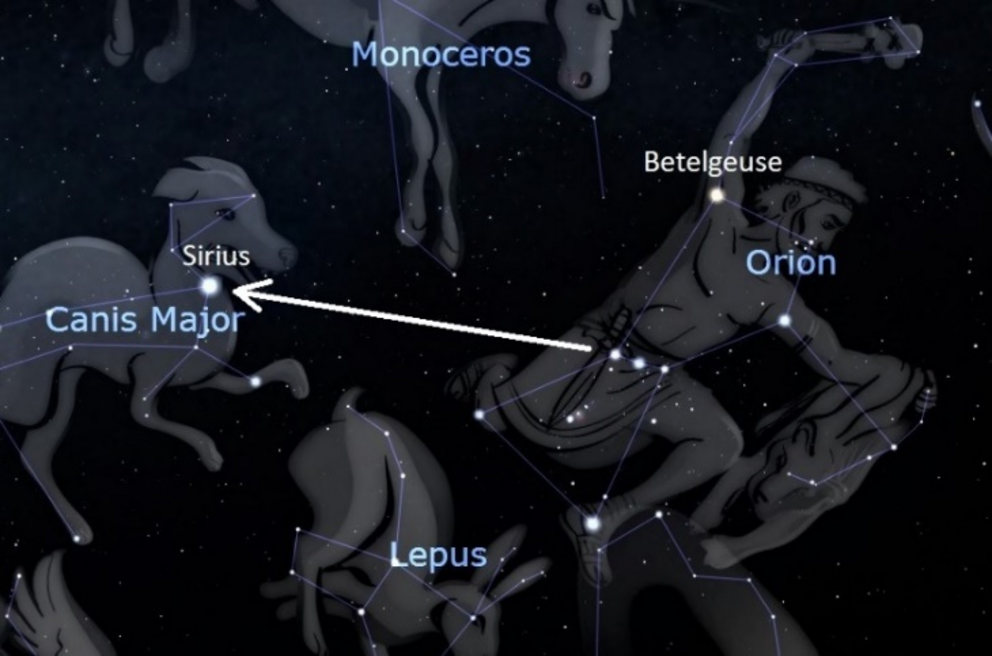
From the reference above to the Heliacal Rising of Sirius in Job 38:15, we find the New Year’s celebrations in ancient Egypt foreshadowing a transition of spiritual power from the archaic Morning Star to the risen Daystar, Jesus Christ. [Pet. 1:19-21]
The fifty-year shared standard between the Sothic Calendar and the Hebrew Jubilee is an intriguing bit of astronomical history with powerful spiritual overtones of the ancient influences of the Biblical Patriarchs, with God’s foreknowledge. In the 50- year half-cycle of the Sothic calendar we find revealing mathematics related to the lunar cycle. According to Schwaller de Lubicz: The 25-year cycle corresponded to 309 lunations. The calculations are:
25 x 365 = 9125 days, and 9125 = 29.5307 days per lunation [309]
This in itself reveals extremely accurate observations. Modern Astronomy reckons the lunation as 29.53059 days, a difference of about a second. But Schwaller de Lubicz notes the intriguing equivalence of 25 years to 309 lunar months. 309=(Ø -1 x 1000 and it’s choice as the number determining the cycle cannot have been accidental. 2
(A double cycle, which expresses the Golden Section, comprises 50 years; 618 = ( Ø – 1 x 1000.) 16 2
As we have seen, the Jubilee cycle is central to the timing of Christ’s birth, and is conspicuous in the celestial events making up the great wonder of Revelation 12. Rosh ha-Shanah on Tishri 1, was the “head” of the Judean calendar as New Year’s day and Jesus’ birthday, the first day of the 50-year Hebrew cycle of Jubilees. This not only set the foundational temporal pattern of the seasons, holidays and feasts of Israel’s ancient Sabbath-Jubilee calendar, but it also mirrors the phi spiral of our solar system, that synchs the orbits of the planets around the Sun. Certainly, it is not a stretch to realize that the same phi ratio ordering the great spiral galaxies of the universe, and patterns the growth of myriad plant species, also patterns our solar system by the same harmony of geometric laws at a varied scale.
Nautilus Shells, Galaxies and Tornadoes, Oh Phi!

In the coordination of the Solar, Lunar and Sothic Calendar, via the phi ratio, not only do we find a symbol of God, the Creator-Father of Lights, underwriting His Creation via His geometric “source of life-principle,” but it also shows a linkage between the precessional and Sothic cycles. As the Creator, He enlivened all life forms, as the Prime Mover, and Giver of the vital life-growth element seen in all four kingdoms of life: plant, animal (and insect), human & spirit kingdoms. As the phi ratio applies to these four kingdoms of life, it operates according the Fibonacci Series, approximating higher degrees of accuracy, unto the Phi standard, witnessed in the successive growth stages of life. This is the reason for the ubiquity of the Fibonacci Series in a myriad of terrestrial life forms. Two of these kingdom’s of life are embodied in the union of the body of the lion king-Leo with the human head of the woman-Virgo, in the Great Sphinx. This section of the ecliptic, forms the Alpha/Omega point on the band of constellations termed the Mazzaroth, that I’ve called the Celestial Sphinx. Below Figure 7, displays the view over the horizon from Jerusalem, showing Virgo’s Head under the fully risen Leo the Lion, very near the birth of Christ.
Figure 7. The Celestial Sphinx of Virgo and Leo on 9-14-3 BC, three days after Christ’s birth. 17
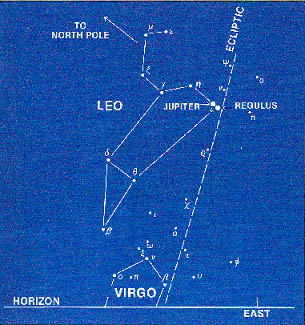
This is the section of the sky that Jon Nessle recently taught us about, which is the target that our Solar System as it spirals forward, led each day with the Sunrise of the daystar, the light of the world-Jesus Christ! Figure 8, below includes both the decans above and below the ecliptic in this part of the sky, showing the serpent Hydra being crushed by the Lion’s claws, with the brightest star on the ecliptic-Regulus between the Lion’s paws, meaning the feet that crush, as he tramples the dragon underfoot; [Ps. 91:13]. 18 Hydra-the abhorred, is the long fleeing serpent stretched from the signs Cancer to Libra, including Virgo and Leo, engulfing the length of 1/3 the ecliptic signs. Other decans pictured are Crater, holding the wine of God’s Wrath, [Rev. 14:10], inseparable from Hydra, and Corvus-the Raven one of the birds of prey who feast on the eternally defeated dead carcasses of the ungodly.
Figure 8. The Alpha/Omega section of the Mazzaroth. 19
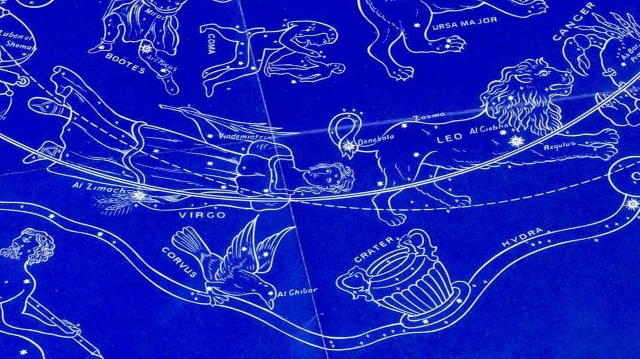
As we have seen, the Great Pyramid on the Giza Plateau embodies the Star Al Nitak on Orion’s belt. In Figure 9 below, the Great Pyramid is linked to the Great Sphinx by the Causeway between them. As the 3 Giza Pyramid’s are a reflection of Orion’s Belt stars, so the Great Sphinx at Giza represents the Alpha and Omega union of signs on the ecliptic, with the head of the woman-Virgo united with the body of the Leo the Lion, depicting the start and finish of the celestial ecliptic. As the oldest and largest freestanding rock sculpture on the face of the earth, the Sphinx draws our attention to this critical heavenly juncture, joining the great circle of the firmament, the celestial Gospel.
Figure 9. The Great Pyramid linked to the Great Sphinx by the Giza Causeway.
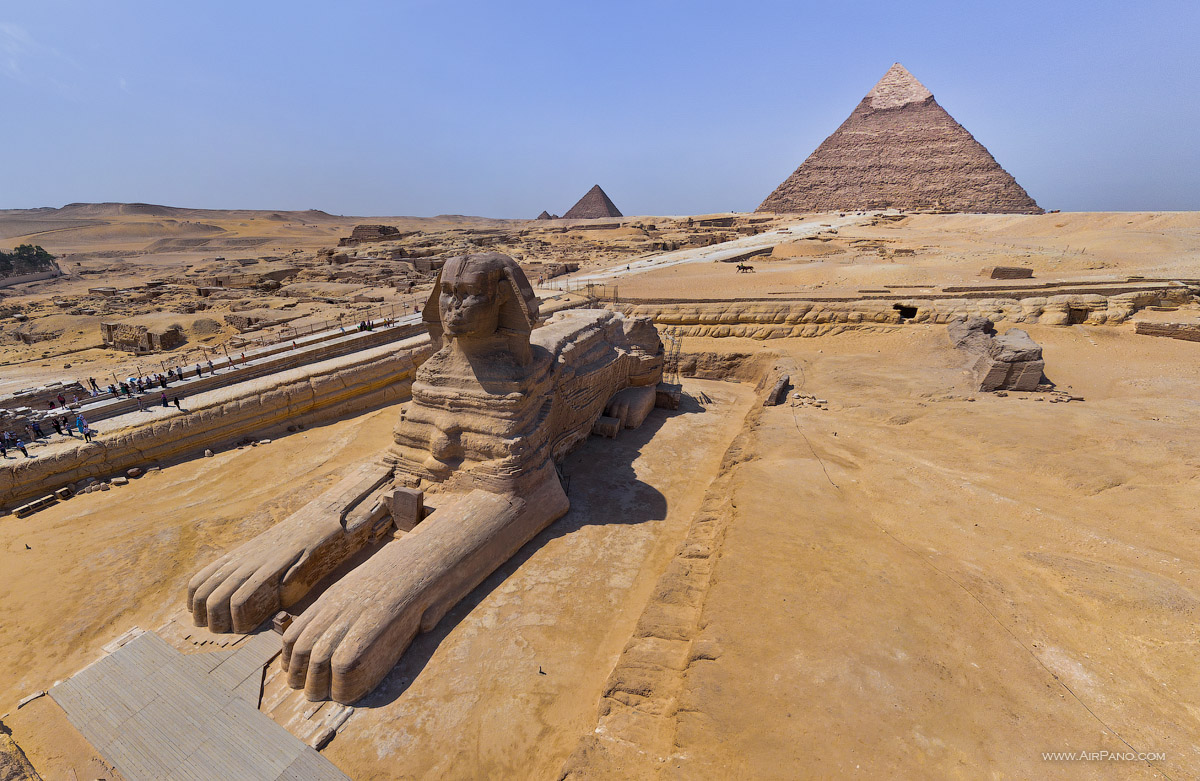
As this Giza Causeway extends from the ancient Plateau to the horizon on the winter solstice of 2012, it aligns with the rising point of Sirius, the Dog Star. When this Causeway line transitions to the firmament, it intersects the Great Orion Nebula between the stars Rigel and Al Nitak of Orion. As we mentioned earlier in this text the “established standard of astronomical navigation of finding the rising point of Sirius once Orion has risen at least 20 degrees, by extending the so-called Navigator’s Line of the 3 stars of Orion’s Belt to the horizon. In the graphic below, the Navigator’s line becomes the line of the Giza Causeway, linking the Great Pyramid to the Great Sphinx to the rising point of Sirius on the Horizon!
In a book by Edward Nightingale called “The Giza Template: The Leo-Orion Relationship,” he shows a phi relation of the Sphinx to the Pyramids at Giza, in effect a master plan for the Giza Plateau. The following is an excerpt from his book. 20
As the Sphinx views the sky oriented eastward through the year, The year is divided into months, days, hours, minutes and seconds. Using these six divisions of time, a calendar date was assigned using a binary date to the alignment of the Galactic Center with the Sun and Earth. It is from this alignment that the Gregorian, Mayan and Hebrew calendar reconcile. This date is encoded at Giza by drawing a 12° degree angle between an 11° degree division of the square and an 11° degree division of the circle creating the multi-angled Causeway of the Great Pyramid. So, what do we see on the horizon at that moment from the viewpoint of the Sphinx?
Figure 10. The Great Sphinx aligned with the Sirius-Pleiades “Navigator’s line” through Orion’s Belt. 21
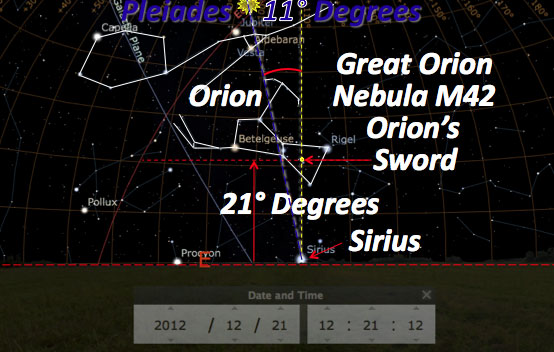
Using Stellarium software to view the sky on this binary date and time from the coordinates of the Sphinx, shows without doubt, the reality and precision of this design. The star Sirius is on the horizon, The Great Orion Nebula, M42 in Orion’s Sword is 21° degrees above the horizon and directly above Sirius. A line drawn between Sirius and the Pleiades is 11° off vertical, and is pointing to this 11° angle. It is this view of Sirius on the horizon, the position of the Pleiades, and the relative position of the Great Orion Nebula that is being tracked and documented. The movements of the star Sirius and the Pleiades star cluster are at odds with the current theory of precession in that they do not exhibit the so-called wobble motion of the Earth’s axis. This implies that Sirius and the Pleiades are on a similar trajectory as our solar system. In fact, that is exactly what I have discovered encoded in The Giza Template. I propose that our solar system, the star Sirius and the Pleiades star cluster system were birthed from the same stellar nebula, that being the Great Orion Nebula, M42. These three systems are each on their own spiral trajectory, each being separated by time and distance directly related to the 25,920 year cycle of the Precession of the equinoxes. These star systems are moving away from the M42 Nebula in a spiral motion with our ecliptic rolling along like a wheel on a spiral path. This movement defines what we view as the precession of the equinoxes, eliminating the outdated wobbling earth theory. Spiral motion and growth are seen throughout the natural world and need not be dismissed in light of celestial mechanics that account for precession. [https://grahamhancock.com/nightingalee3/] Here the Phi ratio mechanics are implied ruling over the Precession of the Equinoxes, supplanting the “wobbling earth theory,” which seems to be supported by the math of the supposed error in the Pyramid’s alignment from the cardinal points.
Another interesting element to this graphic is seen with the 11° line from Sirius to the Pleiades also intersecting Orion’s belt @ Al Nitak– the “wounded one” in reference not only to the Great Pyramid star shaft alignment, but also Gen. 3:15, and the dual head and heel wounds of the serpent and Christ. With the Sword of Orion [M42 Orion’s Nebula] over the head of Sirius at its lower culmination on the horizon, this seems to beautifully depict the destruction of the enemy, while giving added meaning to Job’s Pleiades references, that always include Orion’s Belt. This also fits with the “Scored lines” alignment of the Pleiades in the Pyramid’s Descending Passage intersecting Thuban’s trajectory into the pit, and the precessional shift, and the movement of the archaic pole star towards Polaris, of Ursa Minor. It seems the Almighty had great purposes in mind with Biblical Archaeo-Astronomy of the Giza Plateau, in conveying primary Biblical themes regarding the birth and return of His only begotten Son, the Lord Jesus Christ! We remain ever thankful for His Love and Grace, and the riveting evidence He has left for us, with eyes to see and ears to hear…
Merry Christmas, Happy New Year and God Bless!
Agape’
Rene’

Footnotes
1.Fig.1 picture credit, [humanoriginproject.com]
2. Fig. 2 picture credit, [http://dream-prophecy.blogspot.com/2013_09_01_archive.html]
3. Secrets of the Great Pyramid, ppg 86-87, Peter Thompkins.
4. Witness of the Stars, p. 151. E.W. Bullinger.
5. Fig. 3 picture credit, Stellarium Astronomical Software.
6. Fig. 4 picture credit, [http://www.ancient-wisdom.com/Ghizaarchitecture.htm]
7. The Great Orion Nebula. [www.constellation-guide.com]
8. Fig. 5 picture credit, from [Pinterest.com]
9. Star Lore Myths Legends and Facts, p. 409 William Tyler Olcott
10. IBID, ppg. 408-409
11. IBID, p. 420
12. The Mazzaroth, Frances Rolleston
13. The Illiad-Homer quoted in Hamlet’s Mill, Santillanna & Von Dechend. p.286.
14. Hamlet’s Mill, Santillanna & Von Dechend. p.284.
15. https://nexusnewsfeed.com/article/spiritual-psychic/orion-taurus-and-the-pleiades-a-star-map-of-the-legends-of-kartikeya-horus-and-nergal-and-apollo/
16. Serpent in the Sky J.A. West, p. 94.
17. Fig. 7 Picture credit “Jesus Christ our Promised Seed.” p.45, American Christian Press
18. The Gospel in the Stars, p.134 Joseph Seiss
19. Fig. 8 Picture credit, [www.atam.org]
20. https://www.thegizatemplate.com/
21. IBID
Comments on Facebook
To those of you interested in commenting on this post please go to our Facebook Group Page







